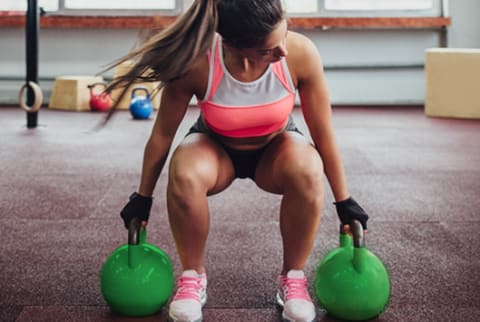Advertisement
So You Want To Start Lifting Weights. Here's Exactly What You Need To Know



If you're not weight training yet, it's time to start resistance based exercise. Maybe you think cardio is sufficient, but it's not enough to prevent strength decline that happens with aging. Cardio exercise (such as swimming, walking, and running) does not specifically build muscle. With age, your body loses muscle mass, your bone density starts to decline, and your posture starts to deteriorate.
Here's the good news: Proper weight training can help combat all of these age-related changes. Additionally, if you are active in sports (and not performing strength exercises), you could be setting yourself up for injury. For example, recent research shows that impaired hip strength more than doubles your risk of ACL tears1.
Where should you begin? Navigating the weight room can be overwhelming at first, so here are some tips to get you started:
1. Take the time to learn proper form.
This will take time, so start simply, and don't overwhelm yourself with endless exercises. The basics seem boring at first, but your body will thank you for it.
2. Eliminate clutter.
Understand that the weight room presents itself with endless variations to work the same muscle group. For example, with squats, you can use barbells, kettlebells, walls, hack machines, Smith machines, TRX suspension, dumbbells, etc. This makes the weight room overwhelming. First, master what constitutes a proper vs. improper squat. For example, learn a good squat using a single piece of equipment before trying the endless variations!
3. Don't weight train every day.
The American College of Sports Medicine recommends that all healthy adults weight train at least two days a week. Therefore, as a beginner, start with two days. Don't go nuts! Work your lower body on Day 1 and your upper body on Day 2, or do total body twice a week (making sure to rest at least one day in between). It's that simple.

4. Prioritize some exercises over others.
Some exercises give you more bang for your buck. For your lower body, master double-leg squats, calf raises, and hamstring curls before trying anything else. For your upper body, master push-ups, back rows, and back reverse flies. If you do this, you will have your entire body covered (even your core).
5. Know which areas are injury-prone.
The lower back, knees, and shoulders are the areas most susceptible to injury when weight training. For your lower back, if you excessively arch or round your spine, you may hurt it. For your shoulders, if you use an improper handgrip, you may hurt them. For your knees, if you overflex or overextend your knees (or even place your feet wrong), you may hurt them. So remember: Proper form is imperative in every exercise you do.
6. Listen to your body.
Realize that getting your heart rate up and burning calories at the gym doesn't mean you are doing so while maintaining proper form. If you overexert yourself, your form will falter and your chance of injury skyrockets. Getting in better condition takes time, so listen to your body!
7. Proceed with caution when taking a group class.
Beware of group classes that incorporate weight lifting (such as CrossFit). Those classes may seem enticing. If you are advanced and in superior shape, you probably can handle such classes without any problem. But as a beginner, joining such classes—even though they may sound exciting—could be setting yourself up for serious injury.
8. Don't assume that all weight machines are safe.
Some of them can be exceedingly dangerous. For example, the Roman Chair can hurt your low back in the matter of seconds. The shoulder press machine can force your shoulders into a high-risk position and potentially tear your rotator cuff, while the inverted leg-press machine could break a rib (and injure your low back). Make sure you proceed with caution when using any machine. Ask for help with set up and form from someone who knows the machine.
9. Don't assume your personal trainer knows everything.
These days, getting certified as a personal trainer isn't too challenging. If your trainer recommends an exercise (and something doesn't look or feel right), just say no. I've known many people (including my own mother) who have suffered severe gym injuries under the supervision of a certified personal trainer. Yikes.
10. Be patient with yourself.
If you are just starting out, you will get sore. Anywhere from 24 to 48 hours of soreness is typical and expected as muscles hypertrophy or get bigger. Anything greater than 48 hours of soreness may be too much for your body, so potentially take down the weight or the reps during your next workout. Soreness will subside with time, so be patient.
What's the best thing for soreness? Though this may seem counterintuitive, the best thing for soreness is more movement—so if you're feeling sore from the weight room, try going for a walk or run.
Watch Next
Enjoy some of our favorite clips from classes
Enjoy some of our favorite clips from classes
What Is Meditation?
Mindfulness/Spirituality | Light Watkins
Box Breathing
Mindfulness/Spirituality | Gwen Dittmar
What Breathwork Can Address
Mindfulness/Spirituality | Gwen Dittmar
The 8 Limbs of Yoga - What is Asana?
Yoga | Caley Alyssa
Two Standing Postures to Open Up Tight Hips
Yoga | Caley Alyssa
How Plants Can Optimize Athletic Performance
Nutrition | Rich Roll
What to Eat Before a Workout
Nutrition | Rich Roll
How Ayurveda Helps Us Navigate Modern Life
Nutrition | Sahara Rose
Messages About Love & Relationships
Love & Relationships | Esther Perel
Love Languages
Love & Relationships | Esther Perel











